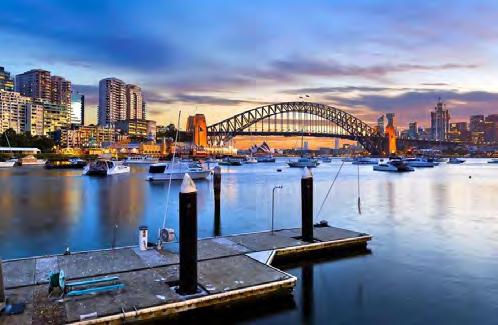
5 minute read
Prologue and Site Information
Part 1
Prologue and Site Information
Advertisement
Prologue
Introduction
The workshop was a joint studio project between Yaguchi Lab of Waseda University and the UNSW UC studio. In this workshop, students were expected to work in small groupsfocus focusing on a design of a resilient multi-functional community on 2 selected sites along the waterfront of Sydney Harbour (Lavender Bay and Camillia). The sites are models of a water urban community suitable to withstand threats posed by highsea level rise, floods, extreme weather caused by the Climate Change in the next decades. Ideally the project features will be flexible enough to be adapted or serve as reference to other Australian and Pacific Rim cites. Due to the ongoing COVID-19 pandemic, Waseda students and UNSW students worked in their respective countries. Thus, UNSW students did field servey while Waseda students based on literature research however both students shared their findings in weekly meetings.
Schedule
This workshop was a 2-month-long studio that began in late February of 2022 (From Feb 21 to May 2). The workshop consisted of three parts, lectures, meetings and actual presentations. The lectures were given by each tutor, Dr. Raffaele Pernice, Shaowen Wang from UNSW, Dr. Tetsuya Yaguchi from Waseda and other guest lecturers from outside the university. All meetings were held online from 9:00 to 12:00 (JST), and each group from both universities shared their progress. In the final presentation, each group proposed the masterplan of their site and received feedback from tutors and guest jurors from UNSW.
• Feb/21: Orientation and Introduction Site Analysis (SWOT),Visions & Strategies Making • Mar/13: Tentative Determination of Visons Brush up Site Analysis, Strategies and Visions • Mar/23: Instituting Masterplan Frameworks • Mar/28: Midterm Presentation Revising Masterplan • Apr/25: Determination of Masterplan Instituting Spatial Strategies • May/2: Final presentation
Site-Camellia
Site-Lavender Bay
Aims and Outcomes of the Workshop
This is an experimental design studio which aims at integrating the 2 scales of architectural and urban design processes whilst investigating the notion and feasibility of proposing innovative and structured urban model as a prototype to orchestrated future developments as well as conserving and improving the current city. Students will articulate their theme/research question of how water cites can manage the current and future challenges related with the climate change and the high sea level threats. The studio endeavours to foster a visionary yet critical approach to design, whilst maintaining a focus on quality measures informed by the context of the space. Students are encouraged to seek out and articulate alternative models of project envision, staging and delivery, applying critical design thinking to current design norms. Especially important will be how these new models will be challenged by the future built environments that are formed by the destruction/reconstruction of the natural and urban landscape, the planning and design of communities and habitats suitable for the contemporary and future city, and the influence of eco-urban design approaches and strategies resulting from the threats of global warming and climate change.
Site Information
Lavender Bay
Lavender Bay is suburb residential area consisted of 3 districts, McMahons Point, Lavender Bay, and Milsons Point. The place was named after George Lavender, the boatswain of the prison hulk "Phoenix". The area is adjecent to North Sydney Central Business District (CBD)where is major commercial district on the Lower North Shore of Sydney to the north, and Sydney CBD, the historical and main commercial center of entire Sydney region to the south over Sydney Harbour. The city is one of the historical area where still remains several heritages that played an important role in area development since 19th centuries. For example, Lavender Bay Railway station was once a temporary terminus of The North Shore Line due to Sydney Harbour Bridge construction in 1920s. Moreover, Luna Park is an amusement park opened in 1935 and while it repeated its closure and reopening several times, now it is one of two amusement park in the world that are protected by government legislation. Lavender Bay is one of the luxury residential area with rich heritages and parks, great view capturing entire Sydney area, and high convenience locating near 2 CBDs. Therefore, it has a potential of rising market value in the future.
Resources [1] https://www.realestate.com.au/ [2] https://www.sydneyharbourhighline.org.au/ [3] https://www.klook.com/ja/activity/17441-luna-park-ticket-sydney/ [4] https://www.escape.com.au/ A View from Lavender Bay[1]


Luna Park[3] Lavender Bay Railway Station in 1920s[2]


Wendy's Secret Garden[4]
Camellia
Camellia is an industrial area sandwiched between the Parramatta CBD and Olympic Park, bordering the Parramatta River, approximately 20 km from Sydney CBD. Camellia's development began in 1788 when Governor Arthur Phillip visited the area as a new settlement. Since then, Camellia has flourished with industries such as leather goods and building materials, followed by the Clyde Refinery in 1925, which played an important role in the neighborhood’s fuel supply. However, with the closure of freight routes and refineries, and plans to downsize fuel import facilities, the area is in decline as an industrial area. The challenges in the area also include soil contaminated by industry, poor accessibility due to heavy passing traffic and lack of bridges, and the flood hazard of the surrounding Parramatta River and its tributary, the Duck River. By resolving these challenges and planning a waterfront that triggers synergies with other CBDs and the Olympic legacy, the development of a broad livable area along the river is expected to be possible.
Resources [1] https://en.wikipedia.org/wiki/Camellia,_New_South_Wales [2] https://www.dailytelegraph.com.au/ [3] https://www.raywhitecommercial.com/ [4] https://hiparramatta.com/sydney-olympic-park-2/ Camellia's Brown Field[1]


Parramatta CBD[3] Parramatta River[2]


Sydney Olympic Park[4]


